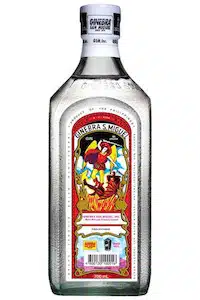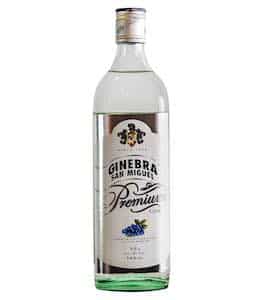Ginebra San Miguel is a Dutch-type Gin (Genever) with an alcohol content of 40%. It's based on a neutral sugar cane spirit and its taste is predominantly junipery with a rather harsh alcoholic bite. Besides juniper, there are few other botanicals that shine through. To mask the alcoholic notes when drinking, Ginebra San Miguel is best served in cocktails that contain ingredients with strong flavors.
During our visit to the Philippines, we had the chance to try their famous gin. -We don't recommend drinking it neat, yet, San Miguel was refreshingly different.
Learn more about Ginebra San Miguel, how it tastes, and how you should drink it in our review.
Ginebra San Miguel Gin Review Summary
- Produced By: San Miguel Corporation
- Owned By: San Miguel Corporation
- Product Website: to product website
- Production Location: Mandaue City, Cebu (Philippines)
- Classification: Gin
- Known botanicals: Juniper, citrus fruit peels, juice extracts, angelica, molasses, coriander seeds, and a selection of herbs
- Base Spirit: Neutral cane spirit
- Aging: No Age Statement (NAS)
- Proof: 40% ABV
- Price: $16 / 1000 ml
- Overall Rating: ★ ☆ ☆ ☆ ☆ (1/5)
Tasting Notes
When I open the bottle, a strong smell of juniper and an intense alcoholic note comes to me. In the background, I can also detect some spicy and peppery notes as well as hints of coriander.
On the palate, the gin is relatively sweet due to its sugar cane base. The level of sweetness is best described as a cross between a London Dry Gin and Old Tom Gin. Though, the flavor profile is heavy in juniper and quite classic.
The dominant flavor is piney juniper and has a biting alcoholic taste. Besides that, you can only guess other flavors. Overall, the quality and complexity are way below average.
On ice
Once you pour it over ice, the piney juniper flavor is muted, and the spirit has a slightly less alcoholic bite. However, the other botanicals don't benefit from that.
Tastewise, Ginebra San Miguel gets closer to (sweet) vodka when served on ice. Only faint juniper notes remind me that this is actually gin. A splash of lemon juice helps to make it more palatable, but I wouldn't recommend drinking this gin neat or on ice.
Cocktails
Gin and Tonic
Using Ginebra San Miguel in a Gin and Tonic helps to cover most of the harsh notes of alcohol. You get the classic combination of juniper and bittersweet tonic water, but again the complexity is lacking.
You can improve the taste by adding two slices of lemon, a few black peppercorns, and dried juniper berries. But even that does not make the drink a genuinely good Gin and Tonic.
Negroni
I was reluctant to use this spirit in a Negroni. I love the flavors in this Italian Aperitivo and thought this gin might butcher it. However, the bold flavors of Campari and sweet vermouth helped a lot. Both ingredients masked the alcoholic flavors well and balanced out the weak flavors of the gin.
It wasn't the best Negroni I ever had, but it was by far the best drink I made with Ginebra San Miguel. It only added strong juniper notes and a molasses-like sweetness, but it worked quite alright.
Gin Fizz
To put it short, I didn't like San Miguel gin in a Gin Fizz cocktail. Lemon juice and simple syrup covered the alcoholic notes well, but overall the drink tasted very flat.
Bottle design
At first glance, the bottle design of Ginebra San Miguel seems quite unassuming. An image of an angel fighting a demon decorates the small square-shaped bottle.
However, if you are a little more involved with the brand, you will notice that the bottle shape alone creates a signature look. In the Philippines, this shape is often named "cuatro cantos".
The label design is known as "Marca Demonio" and was created in 1917 by artist Fernando Amorsolo. It depicts the archangel St. Michael and a defeated demon.
Botanicals
Only little is known about the botanicals that go into San Miguel Gin. The brand only states that its product is flavored with juniper berries and a mix of other ingredients.
At least, after talking to people connected to the brand, we can say it must include molasses, citrus fruit peels, juice extracts, and herbs on top of European-harvested juniper berries.
Brand
The name San Miguel might ring a bell to you - but associated with beer rather than gin. The company behind both products is the same and is not, as many believe, Spanish but from the Philippines. And, believe it or not, their San Miguel gin is outselling all other gin brands - from Gordon's to Tanqueray to Beefeater. [1]
The main reason for that is the per capita gin consumption in the Philippines. It is higher than in any other country in the world. That again is strongly related to San Miguel Gin. Not because the quality and taste are outstanding but because a bottle of this gin sells for about $2.
Where San Miguel produces its gin
The most distinct feature of San Miguel Gin is its base spirit made from sugarcane, which adds a natural sweetness. Typically, sugarcane is the base to produce Rum or Rhum, though. So this is pretty extraordinary.
Also, San Miguel produces its gin at six different distilleries - five located in the Philippines and one in Thailand.
- Mandaue City, Cebu
- Santa Barbara, Pangasinan
- Cabuyao, Laguna
- Cauayan, Isabella
- Ligao, Albay
- Kanchanaburi (Thailand)
History
The gin brand Ginebra San Miguel was founded in 1834. Back then, the spirit used to get produced at the Ayala Distillery in Quiapo, Manila which also makes other alcoholic beverages like anisette, brandy, rum, whiskey, and gin.
In 1924, the brand was acquired by La Tondeña - later renamed La Tondeña Distillers, Inc. (in 1987). Since 2003, the company has been operating under its current name Ginebra San Miguel, Inc.
In 2012, the gin, alongside four other Ginebra products, received a gold medal at the World Quality Selections, organized by Monde Selection.
Here's an interesting side fact: the gin brand is probably the only one to be tied to a basketball team with the same name. The Barangay Ginebra San Miguel is part of the PBA (Philippine Basketball Association).
Different expressions

Ginebra San Miguel
The classic expression is the most popular of the three bottles Ginebra San Miguel has on offer. The 80-proof spirit is a favored mixing spirit in many Asian countries, especially in the Philippines.

GSM Blue
This lighter version is only 65-proof and is therefore not officially allowed to be called a gin. The botanical selection and flavors are similar to the original, but the lower amount of alcohol makes it easier to drink.
GSM Blue lately also comes in various flavors like Mojito, Margarita, and Pomelo.

Ginebra San Miguel Premium Gin
This upscale version is lighter (only 70-proof; 35% ABV) and has more citrus notes. The citrus flavors overshadow the juniper notes and are the dominant taste of the gin. It's less harsh, thus, a lot easier to drink neat compared to the original San Miguel Gin.
How much is Ginebra San Miguel?
The prices in the Philippines are super low. A bottle of the original San Miguel Gin sells for about $2, and the Premium version is sold at around $4. In Western countries, the spirit is a lot harder to get. If you're lucky to spot it in the US, it typically sells between $13 and $15.
Overall
Ginebra San Miguel is not a gin I would recommend to anyone looking for a good gin. -Not for drinking neat and also not for mixing in cocktails. However, the low price makes it quite appealing, and it can work in some cocktails, especially when paired with bold flavors.
My favorite ways of drinking Ginebra San Miguel were in a Negroni or classic G&T, but I could also imagine that it works well in a Red Snapper cocktail.
Related articles
- Elixier Gin review - a woodruff-flavored gin from Germany
- A Look at the global gin market
- Casino cocktail recipe - A classic gin cocktail made with gin, Maraschino liqueur, and fresh lemon juice.

